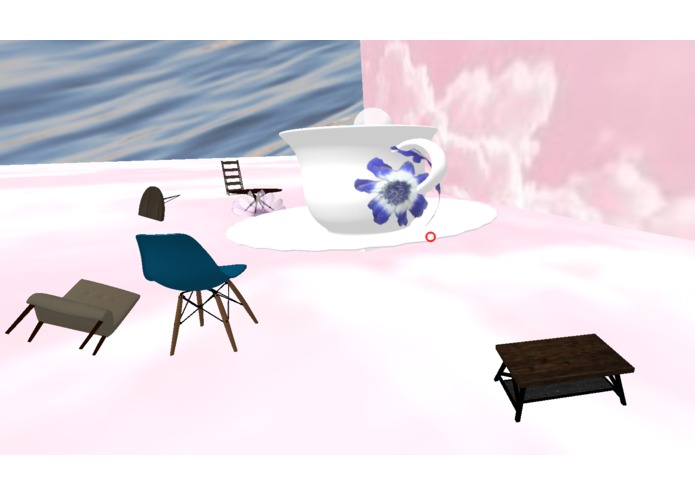
Members of Wesleyan’s Immersive Media Group (IMG) won the “Wayfair Best Use of 3D API” prize at the 6th Annual Wellesley College Hackathon, WHACK, last weekend. The prize was sponsored by Wayfair, an online home-goods store.
Members of the IMG who attended the event included director Aili Niimura ’19, director of communications Will Li ’19, Kevin Koech ’21, Carina Bolaños Lewen ’20, and Sharine Foo ’21. Two non-Wesleyan students, Sarah Abowitz from Smith College and Zachary Neveu from Northeastern University, also participated in Wesleyan’s team. The prize included an Oculus Go virtual reality headset for each group member.
The group won the prize with their virtual reality website titled “The Breathing Room,” which was created over the Nov. 2-4 weekend. The website, which team members created using html, A-frame, and Javascript, included 3D models of Wayfair furniture that users could interact with. It was designed to display the company’s furniture in an artistic virtual environment. More information about the project is available on the team’s Devpost site.
In a message to The Argus, Niimura described the tireless creation of the website.
“Will and I learned html overnight,” she wrote. “We hardly slept the whole time, but it was a ton of fun. The fact that neither of us were programmers felt like a challenge at first, but in the end we had a lot to offer as UX Designer and Sound Designer, and by the end of it, Will had programmed our key interaction, and I had programmed the audio specialization and some animations.”
The group relied on having designers and creatives such as Niimura on the team to craft the look of the final product. The Devpost site explains the IMG’s creative vision, which stood out from competitors’ with its focus on aesthetics and placing Wayfair’s furniture in an audio-visually immersive environment.
“Our idea sparked from room arrangement therapy–who hasn’t totally re-organized their room in a frenzy to feel at peace?” the website reads. “We needed a space where not only we can breathe, but where the room breathes with us. We needed to make a room come to life.”
The site goes on to explain the form and function of the site.
“A spatialised audio navigation takes one through a wondrous open gallery of beautiful objects come to life,” the IMG’s website for the project reads. “This friendly and whimsical abstraction of the often impersonal online shopping experience drops you into a magical world where you can spin detailed Wayfair 3D models. Follow the consequential musical objects, truly delivering an immersive and memorable experience.”
Finally, the website includes descriptions of both the struggles and the accomplishments of the team.
“There were different levels of coding experience, and only one of the members had had experience with A-Frame,” it reads. “Two members are first-time coders, so we definitely took some time to learn from our more experienced members…We had an extremely high level of collaboration and diversity of involvement, given the expansive nature of our team members’ interests. This fed our work greatly, and we’re proud of having come together in this way.”
The group’s page hints at the possibility of more surreal virtual reality experiences in the future, employing the same free-form environment used to display the Wayfair furniture in the group’s most recent project.
The Hackathon, a relatively new meeting of students interested in developing and designing websites, was created as a space for collaborative computer programming. WHACK 2018 held social events, team building activities, and programming workshops. It also included a keynote speech from diversity and technology advocate and entrepreneur TeLisa Daughtry, author of “Learn, Lead, Launch: a FlyTechnista’s guide to Tech FLY & Hustle FLY.”
Niimura, who is majoring in music and the College of Letters, spoke about the formation and goal of the IMG.
“The Immersive Media Group is a student network aimed at facilitating projects and conversations relating to emerging immersive technologies through inclusive collaboration across disciplines and backgrounds,” she wrote. “It’s meant to mend the bridge between STEM and the arts/humanities, with a focus on new medias and technologies (bringing our ideas into the future).”
The IMG targets its recruitment at populations that are underrepresented in STEM fields.
“The group has at its heart the intention to include and recruit those who are typically excluded from these areas,” Niimura said. “If women and people of color can get involved with new technologies at the early stages of its development and popularization, we can ensure a slightly better future than the apocalyptic trope that discussions of [new technologies] tend to evoke.”
Niimura emphasized the importance of this group for Wesleyan students, especially as they form plans for after graduation.
“Few students graduate with a portfolio or website in place–through Immersive Media Group, students (from any background or major) needing a portfolio…can work together on boosting their portfolios in ways our classes are not prepping us to do,” she wrote. “Wesleyan is super behind in this realm… so for students hoping to engage in these mediums, we need to rely on one another.”
The IMG hosts regular workshops for students of all levels of programming experience with various programs like Unity and Supercollider. The group hopes to hold a student forum and group exhibit next semester.
To join the IMG, students should email immersive.media.group@gmail.com to be added to the group’s listserv.
Meredith Olin can be reached at molin@wesleyan.edu.



Leave a Reply